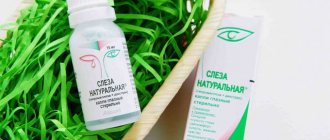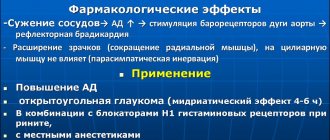Eye drops are medications to eliminate ophthalmological problems: dryness, inflammation, complications after operations. Among them are special drops that doctors use when conducting examinations and diagnostics. These medications include Tropicamide. But in the last 5 years, this drug has found another use - a drug.
What is tropicamide: instructions
Reading the instructions for using tropicamide, we dwell on overdose and side effects and contraindications.
- Contraindications: glaucoma, allergic reactions.
- Side effects: burning sensation, blurred vision, attacks of glaucoma, photophobia, etc.
- Overdose: When used topically as prescribed by a doctor, overdose is unlikely - the answer to most instructions for use.
Nothing life-threatening, everything is absolutely safe. Yes, at first glance it is safer than activated carbon. But looking into the dark corners of the Internet and surfing websites for drug addicts, interesting information emerged... Those who are used to getting pleasure from taking various drugs are tirelessly looking for something new. They often have to re-read many pharmacological reference books, in which they find medications containing drugs. One of the medications that drug addicts misuse is tropicamide. This medicine is an M-choline blocker. This group of medications gets its name from the function they perform in the human body. These substances interfere with the transmission of nerve impulses passing through receptors in the central nervous system called M-cholinergic receptors.
Consequences of using Tropicamide
The use of these eye drops to obtain a dubious “high” quite quickly leads to the formation of mental dependence with an irresistible craving for the introduction of a new “dose”. After just a month of regular use, a person is unable to stop taking the drug on his own and requires qualified medical assistance.
Please note: The main reasons for the popularity of Tropicamide among drug addicts are the low cost of the drug and the free sale of this drug. Until 2015, eye drops were not included in the list of potent substances, and their circulation was not strictly controlled.
The consequences of using Tropicamide intravenously and intranasally have not been sufficiently studied to date. Doctors have every reason to believe that administering the drug in doses many times higher than therapeutic doses poses a real threat to human health. Loss of vision, development of epileptic seizures, and even tissue necrosis and detachment of skeletal muscles from bones are possible. Persons with an established addiction are characterized by a significant decrease in body weight (up to cachexia), deterioration of memory and cognitive abilities, as well as frequent dizziness even with complete cessation of the drug. The skin acquires a yellowish (waxy) tint, and the level of hemoglobin in the blood drops to critical levels. The most life-threatening effects of Tropicamide include respiratory depression and coma. The inevitable decrease in immunity greatly increases the risk of severe infections. Thus, the harm from the “pharmacy drug” Tropicamide is obvious. There is evidence that the life expectancy of a drug addict is reduced to 2 years.
Stopping taking this drug causes withdrawal symptoms, i.e. the syndrome is much stronger than after taking other psychotropic drugs. It is accompanied by severe muscle and joint pain, panic attacks and manifestations of aggression towards others.
Using a drug for other purposes often leads to poisoning. In case of an overdose of Tropicamide, slow intravenous administration of the antidote - physostigmine salicylate - is necessary. The required volume is determined at the rate of 0.03 mg per 1 kg of the victim’s body weight. In parallel, drugs from the group of β-blockers and benzodiazepines are administered.
How to use Tropicamide in ophthalmology and why
This medicine is available in the form of drops. And these drops are put into the eyes. The drug blocks the nerve receptors that are located in the eyeball, thereby dilating the pupil of the eye. This property of the substance is used by ophthalmologists. The fact is that when the patient's pupils are dilated, this allows them to clearly see the fundus of the eye. This medicine is also an anti-inflammatory agent, and it effectively soothes the eyes during various inflammatory processes that may occur in them. But the properties of tropicamide are not limited to its effect on certain receptors of the nervous system located in the human eye.
Content:
- What is Tropicamide and its use in official medicine: 1.1. Legislative framework and sales in pharmacies.
- Effect on the body: 2.1. Signs of withdrawal. 2.2. Consequences of drug addiction.
- How to quit Tropicamide: principles of therapy.
According to the pharmacological classification, Tropicamide belongs to drugs that block M-cholinergic receptors of the central nervous system.
It itself has a pronounced psychoactive effect, but is often used to enhance the effects of other drugs. Thanks to its availability and legal sale in pharmacies, the drug has gained popularity among young people and teenagers, so the question of how to wean yourself off Tropicamide is especially acute among parents of high school and first-year students. Do these “harmless” eye drops really pose a health risk? Can they cause addiction?
Tropicamide: use as a drug
Initially, drug addicts used the substance to hide the constriction of the pupils of the eyes, which is a characteristic symptom when using most opium-based drugs. However, over time, they were able to discover one more property of this drug. When using a pribiotic, people under a narcotic potion felt its effects more strongly. Thus, they realized that this substance enhances the effect that drugs have on the human body. Thanks to this property, patients who had already suffered from drug addiction for a long time, for whom taking the next dose simply meant coming to their senses, were able to feel a real “high” again.
And in addition, drug addicts managed to save money, since taking the substance allowed them to reduce the dose of the drug they took by almost half. However, as they say, you have to pay for everything, and along with the intensification of the feelings of drug intoxication, the consequences of drug addiction also became stronger. The pains of drug withdrawal became so terrible and unbearable that most drug addicts could not stand it and committed suicide. In addition, as it turned out, the use of tropicamide itself caused drug intoxication in drug addicts. For this reason, many people tend to consider this medication a drug. But this substance is not a derivative of opium. Under the influence of the drug, drug addicts do not experience exactly the same sensations that they feel while under the influence of morphine, heroin, or something similar. These sensations are more similar to those that drug addicts experience when under the influence of hallucinogens.
These days there are many drug addicts who do not have the money to purchase drugs. And it didn’t cost anything to buy a product without a prescription for narcotic use, because its sale in pharmacies was not limited in any way a year ago. In addition, this drug was quite cheap. And although this substance is not a derivative of opium, it still poses a serious threat to humans. The “high” from tropicamide does not last long, no more than half an hour, and therefore drug addicts have to “run” to the pharmacy for the next portion several times a day.
Tropicamide as a narcotic drug
Tropicamide has not been known as a drug for very long. Widespread availability, low price and narcotic effect made it dangerous to use. The drug contains the semi-synthetic psychoactive substance methylenedioxymethamphetamine, known as MDMA. It is responsible for the appearance of hallucinations in a drug addict, which they call “cartoons” among themselves. The effect of the drug lasts 30-40 minutes. It is quite toxic and damages the entire nervous system.
At first, addicted people used the drops for their intended purpose, that is, dripped into the eyes. This way they hid traces of opium use - the most harmless way for drug addicts to use Tropicamide.
A sick fantasy prompted me to use an atypical method of taking the drug—intravenously. Addicts mix this drug with other drugs, which prolongs the effect of the latter. The effect of this killer cocktail lasts up to 6 hours, and can be compared to the “high” you get from ecstasy. More often, this mixture is common among drug addicts who boil opium from poppy seeds and mix them with eye drops.
As such, there is no withdrawal from Tropicamide, but the desire to get a new dose is still constantly spinning in the head and haunts the addicted person.
Tropicamide - consequences of taking
The use of this medication to enhance the effect of drug intoxication caused by other drugs, or to hide the symptoms of drug use can lead to very serious consequences:
- Irreparable damage to the eyes is a sharp decline in vision, leading to blindness. The pupils are artificially dilated all the time, too much light falls on the retina, which over time begins to perceive light poorly, and sooner or later all this leads to the development of blindness;
- The addict's immune system is weakened. He becomes susceptible to many infectious diseases;
- The internal organs of a drug addict, as a result of prolonged intoxication, cannot withstand the load and cease to function normally - which leads to numerous metabolic disorders. In addition, use leads to the development of: nephritis, hepatitis, liver cirrhosis, toxic myocardial dystrophy - these are the most common consequences of use, which in most cases can lead to death;
- Development of organic damage to the human central nervous system. Encephalopathy, epilepsy, etc. In case of overdose, significant damage is also caused to the human body. The drug addict may fall into a comatose state, his body may be seized by convulsions, and in the case of a severe overdose, the person may stop breathing. In such situations, the addict needs urgent medical attention. He needs to cleanse the gastrointestinal tract and then give him a drug that can adsorb the remaining toxic substances.
Signs of Tropicamide use
During the first week, it is impossible to detect signs of taking the medicine. They appear after 2-3 weeks of regular use and appear as:
- Ulcerative rashes on the skin.
- Changes in the color of the epidermis (yellow or gray tint).
- A rapid drop in hemoglobin levels (leading to chronic fatigue and exhaustion).
- Epilepsy attacks.
- Sudden weight loss due to metabolic disorders.
There is also the most obvious way to find out about an unhealthy addiction - to look in a medicine cabinet or a person’s personal belongings. As a rule, a drug addict buys eye drops in huge quantities (so that he does not have to go to a 24-hour pharmacy in the middle of the night). Moreover, the person never suffered from ophthalmological diseases. With the development of polydrug addiction in the apartment, the following may appear:
- Tablets and ampoules.
- Syringes.
- Medical tourniquet.
- Burnt spoons.
People often hide injection marks on their arms and legs. Therefore, even in sunny weather at an air temperature of +30 Co, they wear trousers and a shirt or jacket. It is impossible to determine pathological cravings for medications at home with 100% accuracy. There are test strips for urine or saliva testing, but there are two significant drawbacks:
- Test strips detect the use of 5-10 different types of drugs.
- A person will not voluntarily agree to take the test.
Therefore, for a better result, you need to do tests. When applying to the PND (psychoneurological clinic), having identified an addiction, the person can be registered. To maintain anonymity, you can contact a paid medical institution. You can conduct blood and urine tests for antibodies and metabolites to psychoactive substances anonymously at the Zdravnitsa professional treatment and rehabilitation center. For consultation and to make an appointment for testing, call us at 8.
Treatment of tropicamide addiction in our center
Drug addiction to tropicamide is a serious disease, and even more so if it is associated with drug addiction to opium derivatives. But you can still recover from this disease. At this time, our specialists have already accumulated enough information about this disease, and they have extensive experience in treating drug addiction. If you or your loved one needs to get rid of drug addiction, there is no need to hesitate. Call us. Our clinic will provide you with effective and comprehensive assistance. ☎+7(495)773-03-43
Pharmacological properties of the drug Tropicamide-pharmak
Tropicamide (N-ethyl-alpha-(hydroxymethyl)-N-(4-pyridinylmethyl)benzoacetamide) blocks M-cholinergic receptors of the sphincter of the iris and ciliary muscle. Dilates the pupil, causing paralysis of accommodation. It acts quickly and does not last long. After a single instillation of 0.5% solution, pupil dilation begins after 5 minutes, reaches a maximum after 15–20 minutes and persists for 1 hour. Complete restoration of accommodation and pupil size occurs after 3–5 hours. After a single instillation of 1% solution -ra pupil dilation begins after 5 minutes, reaches a maximum after 20–45 minutes and persists for 2 hours. Maximum paralysis of accommodation after double instillation occurs 25 minutes from the moment of instillation and lasts about 30 minutes. Complete restoration of accommodation and pupil size occurs after 6 hours. It is slightly subject to systemic absorption (especially in children and the elderly).
Signs of an overdose of Tropicamide with systemic use
- Violation of accommodation, pupil dilation. The addict stops seeing nearby objects and sees only at a distance.
- Dryness of the skin and mucous membranes of the eyes, mouth, nose, etc. leading to hyperthermia (body temperature rises). The skin has a waxy tint.
- Slowness and inability to swallow
- Increased heart rate - tachycardia
- Confusion, anxiety, hyperexcitability, seizures,
- Delusional and hallucinogenic syndromes
Fatal outcome from an overdose of tropicamide eye drops develops as a result of blockade of the respiratory center of the central nervous system.
If your loved one experiences all of the symptoms described above, call 112 immediately, life and its quality depend on every minute of delay.
How to quit Tropicamide: principles of therapy
Drug addiction treatment is carried out strictly in a hospital setting, where the patient is guaranteed not to be able to get another bottle of drops. If there are symptoms of an overdose (critical increase in body temperature, arrhythmia, breathing problems), resuscitation measures are necessary.
There is no specific antidote, therefore, to solve the problem of how to remove Tropicamide from the body, standard detoxification methods are used. This:
- intensive infusion-drop therapy using polyion solutions, plasma substitutes, etc.;
- active supportive treatment to restore systemic disorders: medications are administered to stabilize blood pressure, normalize heart rate, stimulate blood flow, antioxidants and hepatoprotectors are mandatory;
- prevention of complications from the central nervous system: tranquilizers or antipsychotics are administered (the latter are necessary for symptoms of acute psychosis).
But detoxification alone is not enough to stop Tropicamide. The patient needs long-term psychotherapy; suggestive coding methods have proven themselves to be effective. After completing the main course of treatment, you should definitely undergo rehabilitation
, ideally - on the basis of a specialized medical center, where they not only deal with the social adaptation of drug addicts, but also pay great attention to their physical recovery, healthy eating, and sports.
It is impossible to quit Tropicamide on your own! Therefore, you should not waste time trying to self-medicate, which will not bring any results. The drug is extremely toxic, so you need to contact a specialized specialist as soon as you notice symptoms of addiction in a loved one.
Use of the drug Tropicamide-pharmak
To open the bottle, pierce the top of the neck by turning the cap all the way. Instill into the conjunctival sac of the eye by lightly pressing the walls of the bottle. Application of 0.5% solution To study the fundus of the eye - 1-2 drops over 15-20 minutes, to study the condition of the lens and determine refraction - 1-2 drops twice with an interval of 5 minutes, if necessary, prolong the mydriatic effect after 20-30 min additionally instill 1 drop of the drug. Application of 1% solution For fundus examination: 1–2 drops 20–45 minutes before the procedure. To study the condition of the lens and determine refraction: 1–2 drops twice with an interval of 5 minutes; if it is necessary to prolong the mydriatic effect, an additional 1 drop of the drug is instilled after 20–30 minutes. For therapeutic purposes, instill 1 drop into the conjunctival sac 2-3 times a day. The dose should not exceed 4 drops per day.
Why you should contact us
We offer a full course of effective drug addiction treatment. We guarantee:
- Honest prices. Neither more nor less than the cost of drugs and doctors' work.
- Caring for the patient until complete recovery and recovery.
- Anonymity. No one will know that you or your loved one received treatment from us.
- Effectiveness. Provided that the addict complies with all the doctor’s instructions.
- Individual and comprehensive approach to therapy. We select the course for a specific clinical situation.
Side effects of the drug Tropicamide-pharmak
From the organ of vision: increased intraocular pressure, impaired visual acuity, photophobia. Immediately after instillation of the drug, burning and lacrimation are possible, lasting for about 15–20 seconds. From the central nervous system: sometimes - psychotic symptoms, behavior changes (especially in children and adolescents), headache (in adults). From the cardiovascular system: symptoms of circulatory and respiratory failure (especially in children and adolescents), tachycardia (in adults). Other: dry mouth, allergic reactions.



